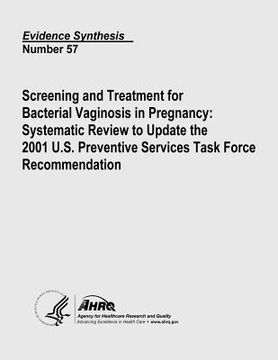Screening and Treatment for Bacterial Vaginosis in Pregnancy: Systematic Review to Update the 2001 U.S. Preventive Services Task Force Recommendation: (in English)
Synopsis "Screening and Treatment for Bacterial Vaginosis in Pregnancy: Systematic Review to Update the 2001 U.S. Preventive Services Task Force Recommendation: (in English)"
The USPSTF last reviewed screening for bacterial vaginosis (BV) in 2001. The USPSTF made the update of the BV topic a priority for 2006. Gaps in evidence evident from the prior recommendation included information that would make it possible to characterize the patients most likely to benefit from screening, evidence about the optimum timing of screening and treatment, information to determine the effect of treatment on pregnancy outcomes, the fact that the screening methods used in research do not reflect those used in practice, and the fact that the findings of studies in U.S. health clinics are not generalizable to community-based practices. Bacterial vaginosis (BV) is the most common lower genital tract syndrome among women of reproductive age. It involves an imbalance in the vaginal bacterial ecosystem such that hydrogen peroxide-producing lactobacilli are diminished and Gardnerella vaginalis, anaerobes, and mycoplasmas are abundant. Symptoms include vaginal discharge, pruritus, or malodor; however, approximately half of women with BV are asymptomatic. Once diagnosed, the microflora imbalance can be altered with a short course of antibiotic therapy. For two decades now, researchers have documented the associations between BV and adverse pregnancy outcomes focusing on preterm birth and timing of treatment. This epidemiologic evidence has been used as a rationale for screening asymptomatic pregnant women for BV. Most data on the prevalence of infection come from academic medical centers or public hospitals. In several large prospective, longitudinal studies performed in these settings, the prevalence of BV has ranged from 9 to 23%. The prevalence of BV in pregnant women seen in community settings is not well studied. BV in pregnancy is more common among African-American women, women of low socioeconomic status, and those who have previously delivered low-birth weight infants. The recently completed National Institute of Child Health and Human Development Maternal-Fetal Medicine Units Network study found that forty-five percent of the African American women in this sample had BV. In a secondary analysis of 4 prospective studies in Denver, rates of BV and other vaginal infections were significantly higher among Black women than among non-Hispanic white or Asian comparators (39.8 vs. 24.6, respectively). A predominantly Caucasian sample of 4,429 pregnant women presenting for routine prenatal care in non-hospital-based clinics in Vienna had a 8.6% rate of BV. The natural history of BV in pregnant women has shown that up to 50% of BV cases resolve spontaneously during pregnancy. Whether or not to screen and/or treat multiple times, and when to start and at what interval during pregnancy, are still unanswered questions, as BV may not necessarily persist throughout pregnancy. Key questions addressed include: 1. Does screening for bacterial vaginosis during pregnancy in asymptomatic women reduce adverse pregnancy outcomes for those at low risk, average, or high risk for preterm delivery? 2. Does treatment of bacterial vaginosis during pregnancy in asymptomatic women reduce adverse pregnancy outcomes for those at low, average, or high risk for preterm delivery? 3. What adverse effects does the screening and/or treatment of bacterial vaginosis have on pregnancy outcomes?

